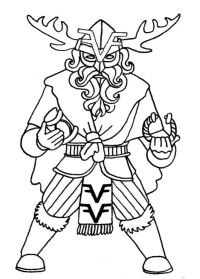 It is accepted that HEORT comes from the Saxon older word HEOROT
from the Common Germanic HERUTAZ; the Dutch HERT; and Old Norse
Norwegian and Swedish HJORTJ ... see the Wiki
Dictionary
It is accepted that HEORT comes from the Saxon older word HEOROT
from the Common Germanic HERUTAZ; the Dutch HERT; and Old Norse
Norwegian and Swedish HJORTJ ... see the Wiki
Dictionary
hartleyfamily.uk - The HARTLEY Surname - Origins of the Name
1] Who are the Hartleys ? When did they originate ?
2] Where did the surname 'HARTLEY' come from ? Why the surname, HARTLEY ?
3] Who were some of the earliest HARTLEYs and where did they come from ?
So if the surname HART-LEY is derived from the Germanic Earth Goddess of Hunting, HERTHA, where geographically did it come from ? Where was it first found ? Why the name HARTLEY and not HERTHALEY ? How did the name change over time ?
Most
surnames seem to have their origins since Norman times ... there were surnames
during pre-Norman Britain and Ireland but records don't reveal much, though
some names have been proved to have survived since Anglo-Saxon or even earlier
times. Often surnames are linked to places, distinctive looks and trades. William
the butcher would have become William Butcher, James with brown hair would have
become James Brown, John of York would have become John York etc.
By 1400 the use of surnames was widespread. New names developed and some were introduced through continued immigration. Some names have changed over time, either the spelling, or through the use of an alias. Using records, it is often possible to trace a surname back to the 15thC and beyond, but you have to bear in mind changes that may have occured, for example, 'Hartley' may have once been recorded as 'Artley', 'Hurtley', 'Hartly', 'Harteley' and so on ...
The HARTLEY surname certainly appeared in Anglo-Saxon times, if not earlier. It doesn't have it's origins since the Norman invasion nor during Medieval times. The surname can be found in pre-Norman times, both in the North and in the South of England, recorded in place-names that pre-date the Norman conquest ... when the Normans arrived they used place-names already named 'Hartley'.
hartleyfamilyorguk believes the Anglo-Saxons used the name HEORT-LEA to name places later referred to as HARTLEY by the Normans ... the Dutch word: HERT; Norwegian and Swedish word: HJORT; Old English: HEORT or HEOROT meaning: 'Deer', 'Hart' or 'Stag Deer' and 'LEA' means a 'Clearing'. There are those who then go on to say the name is derived from the place, they create an image of deer herdsmen named 'HARTLEY', looking after the deer in these 'deer parks' [the clearings having grown in acreage !]
this to be incomplete and therefore incorrect; HEORT was not derived from the name of the place ... it was the other way round, the place was named after the Germanic 'HEORT' ... derived from the Earth Goddess 'HERTHA'. Further, the use of the word 'LEA' meaning 'clearing' referred to a clearing for the worship of the Goddess HERTHA, not where Stags rutted or whatever.
So HEORT-LEA means "place where the Goddess HERTHA is worshipped".
the place name HARTLEY was called in Domesday [1086] ERCLEI and in the Textus Roffensis [1125] HERDEI
The
Saxon 'E' was pronounced as our 'A' and the sound of the 'C' against 'L' is
not unlike that of 'T' and 'L' so maybe the name should have been written 'ARTLEI'
not 'ERCLEI' ? In the case of Hartley, near Cranbrook, the Norman scribe
wrote 'ARCLEI', a half-way compromise ?
So 'ERCLEI' or 'ARCLEI' are the Norman version of the Saxon 'HEORTLEA'.
Æcerbot is an Anglo-Saxon 'charm' recorded in the 11th century. The charm consists of a partially Christianized prayer to produce fruitful land and crops. The charm contains references to both Christian and Anglo-Saxon pagan elements, as well as the mention of "Erce", described as "Mother of Earth". Germanic tribes looked to the Earth for their Mother Goddess. The charm would have been derived from the Mother Earth Goddess Festivals.
In
some places it looks like the name changed over time to: HERCLEGA, then
HURTLEGH, HERTELE, HERTELEGH, HERTLEYE [13thC] HURTLEYE [14thC] HERTELEY [16thC]
... eventually HARTLEY.
In other places, HEORUTLEA HERETSLEY HERTELEIGH HERTLEGH HERTLEY HERTLEGE
HERKELEYE HERCLEYE HERDIE HARLEI HERLEI [11thC] HEORTLEA HERTELEY HARELEY HERTLIGH
[13thC] HURTLEGHE HERTLE [14thC] HERTILEE HERTELE HARTELEY
 It is accepted that HEORT comes from the Saxon older word HEOROT
from the Common Germanic HERUTAZ; the Dutch HERT; and Old Norse
Norwegian and Swedish HJORTJ ... see the Wiki
Dictionary
It is accepted that HEORT comes from the Saxon older word HEOROT
from the Common Germanic HERUTAZ; the Dutch HERT; and Old Norse
Norwegian and Swedish HJORTJ ... see the Wiki
Dictionary
We've all read and watched the Anglo-Saxon epic 'Beowulf' ... was HARTLEY derived from the Danish 'Hall of Mead' HEOROT in 'Beowulf', "the foremost of Halls under Heaven" ?
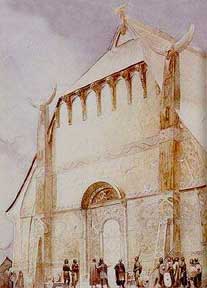 hartleyfamilyorguk believes 'The Hall of HEOROT' was named after or was
a place of worship to the Germanic-Saxon Goddess, HEOROTHA, the mother
of the Norse God, THOR [HEORTE meaning FESTIVAL [see below]]. The Hall served
as a Palace for King Hroðgar, believed to be a Danish King of the Sixth Century.
Heorot means "Hall of the Hart" [stag/male deer]. The Geatish [Swedish] hero
Beowulf defends the Royal Hall and its residents from the demonic Grendel [for
Geats, see 1 and 2 on map below].
hartleyfamilyorguk believes 'The Hall of HEOROT' was named after or was
a place of worship to the Germanic-Saxon Goddess, HEOROTHA, the mother
of the Norse God, THOR [HEORTE meaning FESTIVAL [see below]]. The Hall served
as a Palace for King Hroðgar, believed to be a Danish King of the Sixth Century.
Heorot means "Hall of the Hart" [stag/male deer]. The Geatish [Swedish] hero
Beowulf defends the Royal Hall and its residents from the demonic Grendel [for
Geats, see 1 and 2 on map below].
The Hall functioned both as a seat of government and as a residence for the King's Thanes [warriors]. Heorot symbolized human civilization and culture, as well as the might of the Danish Kings; essentially, all the good things in the world of Beowulf. Its brightness, warmth, and joy contrasted with the darkness of the swamp waters inhabited by Grendel.
Where
was the location of the 'Hall of HEOROT'' ? Are there remains ?
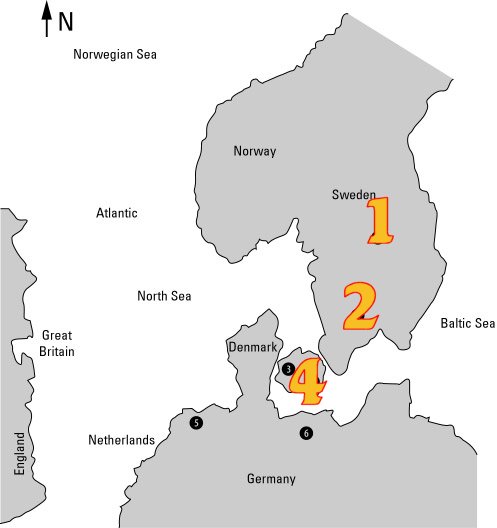 The medieval
chroniclers Saxo Grammaticus and Sven Aggesen wrote that the village of Lejre,
near Roskilde in Denmark was the chief residence of Hroðgar's Skjöldung clan
[called "Scylding" in the poem [Scythian?]]. The remains of a Viking Hall complex
was uncovered southwest of Lejre in 1986-88 by Tom Christensen of the Roskilde
Museum [see 4 on the map]. Wood from the foundation was radiocarbon-dated
to about 880. It was later found that this Hall was built over an older Hall
which has been dated to 680. In 2004-05, Christensen excavated a third Hall
located just north of the other two.
The medieval
chroniclers Saxo Grammaticus and Sven Aggesen wrote that the village of Lejre,
near Roskilde in Denmark was the chief residence of Hroðgar's Skjöldung clan
[called "Scylding" in the poem [Scythian?]]. The remains of a Viking Hall complex
was uncovered southwest of Lejre in 1986-88 by Tom Christensen of the Roskilde
Museum [see 4 on the map]. Wood from the foundation was radiocarbon-dated
to about 880. It was later found that this Hall was built over an older Hall
which has been dated to 680. In 2004-05, Christensen excavated a third Hall
located just north of the other two.
This Hall was built in the mid-6th century, exactly the time period of Beowulf ! All three Halls were about 50 meters long. In Scandinavian sources, HEOROT corresponds to Hleiðargarðr, King Hroðulf's [Hrólfr Kraki] Hall mentioned in Hrólf Kraki's saga, and located in Lejre.
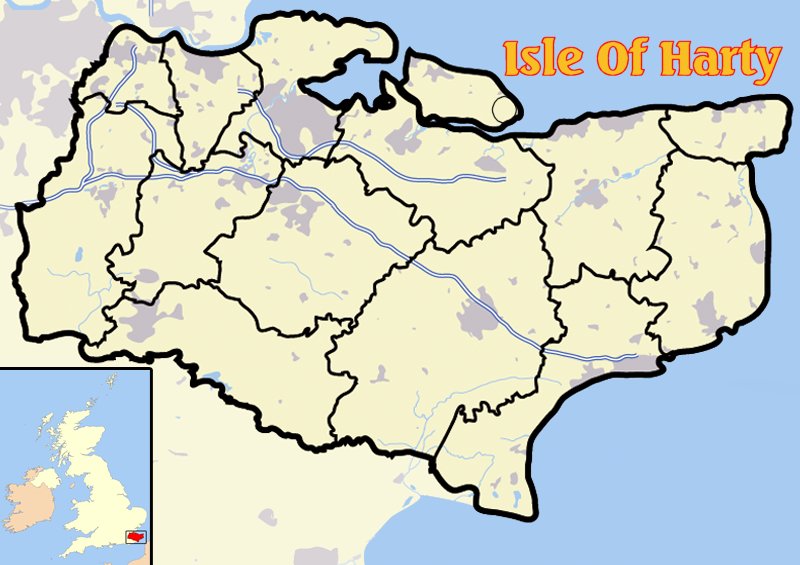 Another
theory puts HEOROT on the Isle of Harty, now part of the Isle of Sheppey
in North Kent, England. Several place-names [see Domesday Book, Kent, below]
and archaeological features in the vicinity are said to correspond to locations
or references in the poem. Archaeologist Paul Wilkinson has identified the Isle
of Hart[y] as synonymous with HEOROT [HART LONDE]. Other place-names and archaeological
features in the vicinity directly correspond to locations or references in the
poem: landes-end, Warden, the straet, the fagne flor, and the Lathe of Scray,
for instance. There are many more. 'straet' is particularly interesting as it
is Old English for 'Roman road' and is a Germanic loan word from the Latin term
via strata 'paved road'. There is still a Roman road leading uphill to the Roman
villa complex/settlement on the Isle of Harty. Just along the coast is the Isle
of Thanet [of the Thanes [Saxon Warriors]] where Hengest and Horsa set up their
headquarters. Two local areas today are Harty Marshes and Leysdown Marshes.
Another
theory puts HEOROT on the Isle of Harty, now part of the Isle of Sheppey
in North Kent, England. Several place-names [see Domesday Book, Kent, below]
and archaeological features in the vicinity are said to correspond to locations
or references in the poem. Archaeologist Paul Wilkinson has identified the Isle
of Hart[y] as synonymous with HEOROT [HART LONDE]. Other place-names and archaeological
features in the vicinity directly correspond to locations or references in the
poem: landes-end, Warden, the straet, the fagne flor, and the Lathe of Scray,
for instance. There are many more. 'straet' is particularly interesting as it
is Old English for 'Roman road' and is a Germanic loan word from the Latin term
via strata 'paved road'. There is still a Roman road leading uphill to the Roman
villa complex/settlement on the Isle of Harty. Just along the coast is the Isle
of Thanet [of the Thanes [Saxon Warriors]] where Hengest and Horsa set up their
headquarters. Two local areas today are Harty Marshes and Leysdown Marshes.
Many of the details of Beowulf's adventure seem to fit a voyage from Scandinavia to Kent. The sea journey from the mouth of the Rhine to Britain was estimated by the 1st/2nd century writer Plutarch to be about 36 hours. Beowulf sighted land on the morning of the second day [the second morning]. If, as would be normal, he had sailed on the evening tide, his journey would have taken 36 hours. Beowulf's first sighting of land is of `sea-cliffs shining, shores steep, broad sea-nesses.' Best landfall on the coast of Britain from the mouth of the Rhine is either at North Foreland on Thanet, or at Sheerness cliffs. The North Foreland displays an optical trick of `shining' when the rising sun strikes the white chalk of the cliffs; in fact in pre-dawn light the cliffs can shine quite dramatically whilst the surrounding ocean is still in darkness, a phenomenon remarked upon by early mariners. Sheerness cliffs display the same natural phenomenon, and the Anglo-Saxon place-name emphasises the point - Sheerness means `bright headland'. Beowulf's voyage ends at a place called Land's End, which interestingly is the name today of a small sea-inlet just to the north of Harty. Above it, the cliffs are called Warden Point, a name recorded from at least the 12th century. In Beowulf, the `warden' of an important Jute/Germanic household stands on the cliffs above Land's End, sees Beowulf's approaching ship and picks his way down to the shore to greet the young warrior. The warden accompanies Beowulf until the hall, Heorot, comes into view. He then leaves him to continue along the `straet' that `climbs up' to the building. Straet is Old English for a Roman road [from Latin via strata, a paved way]. There are no Roman roads in Jutland, but there is one on the Isle of Harty, leading uphill to a Roman villa or settlement on the island. The road was surveyed recently by the Swale Archaeological Survey. It makes sense that Hrothgar's hall was a former Roman villa. On arrival at the hall, Beowulf strides across a `fagne flor' [fine/flagged floor] which the Anglo-Saxon place-name specialist Margaret Gelling suggests [in Signposts to the Past] `could denote the floor of a Roman building which, whether paved or tessellated, would be more elaborate than those of Anglo-Saxon buildings'.
What was the 'Hall of HEOROT' like ?
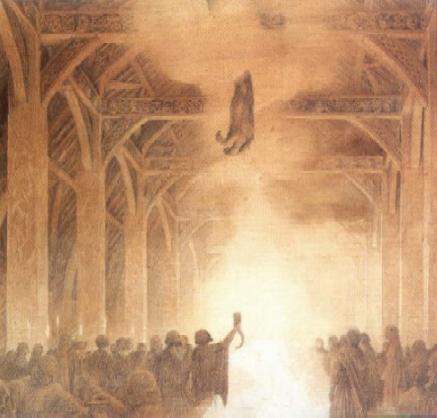 [illustration: Alan Lee 1984]. The building was like a palace. It towered high,
as tall as a cliff. It was large enough to allow Hroðgar to present Beowulf
with a gift of eight horses, each with gold-plate headgear. The gables were
shaped like the HORNS OF THE HART. People from neighbouring tribes respectfully
contributed to the rich decorations and intricate designs.
[illustration: Alan Lee 1984]. The building was like a palace. It towered high,
as tall as a cliff. It was large enough to allow Hroðgar to present Beowulf
with a gift of eight horses, each with gold-plate headgear. The gables were
shaped like the HORNS OF THE HART. People from neighbouring tribes respectfully
contributed to the rich decorations and intricate designs.
Was HEOROT derived from the name of the Germanic-Saxon Goddess HEOROTHA ? Was HEOROTHA the same as HERTHA ?
She was the mother of the Norse God, THOR. Her name was likely derived from HEORTE meaning FESTIVAL.
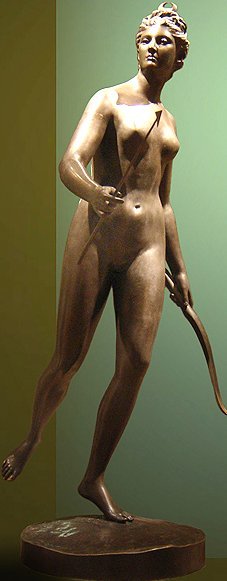 There was a female Germanic Goddess recorded as HEOROTHA simplified to
HERTHA [pronounced HERTA [the Dutch word being HERT] likely
derived from the Germanic-IndoEuropean word HEORTHA meaning EARTH
MOTHER GODDESS. She was worshipped in Festivals by many Germanic tribes
from below the Rivers Elbe and Wesser and around the Baltic Sea including the
Estii, Lombards, the Angles and Jutes from Jutland and Schleswig, and Saxons.
These people are likely ancestors of some [but not all] Hartleys [see I1_DNA
Page]
There was a female Germanic Goddess recorded as HEOROTHA simplified to
HERTHA [pronounced HERTA [the Dutch word being HERT] likely
derived from the Germanic-IndoEuropean word HEORTHA meaning EARTH
MOTHER GODDESS. She was worshipped in Festivals by many Germanic tribes
from below the Rivers Elbe and Wesser and around the Baltic Sea including the
Estii, Lombards, the Angles and Jutes from Jutland and Schleswig, and Saxons.
These people are likely ancestors of some [but not all] Hartleys [see I1_DNA
Page]
HEORTE [pronounced Hey-Or-Tay] comes from the Greek for FESTIVAL or HOLY DAY ... Heortology etymologically implies a relation to Feasts or Festivals in general, an exposition of their meaning. The word, however, is used to denote specifically the science of Sacred Festivals, embracing the principles of their origin, significance, and historical development, with reference to epochs or incidents in the Christian year. So it is likely HEORTE was derived from Feasts and Festivities associated with the Goddess HEOROTHA [HERTHA].
hartleyfamilyorguk
believes the Saxon name HEORT-LEA [hence HARTLEY] was derived from a
Sacred place, a Clearing in a Grove, a 'LEA', where the sacred Earth Mother
Goddess 'HEOROTHA' was worshipped in a Festival. There might even have been
a Temple, a Shrine or Sacred Well named after her, yet to be discovered. Beowulf's
Hall of HEOROT would have been named after her. We know that many old Germanic-Saxon
place names occur elsewhere in Britain. HEOROT-LEY [also HARTLEY] may
have been derived from the area around the Hall of HEOROT ... the area is today
named Hart[y] Marshes and Leysdown Marshes ... much more archaeology needs to
be done in this area to discover the remains.
The HARTLEY Family of Chorlton-cum-Hardy in Manchester derived their name
from 'Hearda's Island' at Chorlton, 'HERTHA'S ISLAND', an island where the Earth
Goddess Hertha was celebrated and worshipped; in the Textus Roffensis [1125]
HERDEI [see
HARTLEY
Family of Chorlton in Lancashire ]
HEOROTHA
is also found in many dialects across Europe as HERTHA, HRETHA, EORTHA [EORTHE
to the Anglo-Saxons], ERTHA, ARTHA, ERDA [Old-German] and to the Goths she was
AIRTHA, hence we get the word EARTH. The Earth is the universal Mother
Goddess, that stands at the origin of all mythologies. Admiration for the Earth
as a living mother was characteristic of the vorpatriarchalischen societies,
because they seemed to have understood better than the later civilizations controlled
of men, how important the preservation of the environment is.
HEOROTHA was the mother of the Norse God, THOR, wife of ODIN, where she was
called JORD or FRIGGA. She is the Goddess of the Soil, the Earth,
and of Peace. She is connected with the fertility and regeneration of the Earth,
and with Springtime.
HERTHA rules Fertility, the Hearth, the Home, Domestic life, and the Wild Hunt. [See Wild Hunt led by Cernnunos, the Horned God]. She is the Matron of Witches and Peace envoys. The many names by which she was known in Northern Europe include Erda, Eartha, Hertha, Herta, Hretha, Hrethra, Bertha, Nerthus, and Rheda or Rhede. Erthaís titles include Mother Earth, and Peace Bringer. Evergreens, especially fir boughs, are sacred to Ertha. She is hostile to iron. Hrethmonath, the month of March, is sacred to her. Ertha is celebrated at Winter Solstice, Spring Equinox, and on May 1. At Winter Solstice yeast cakes called Erthaís slippersí were once baked. The Goddess was said to have visited houses on the night of the Solstice, by descending through the smoke in chimneys, and filled the slippers with small gifts for the members of each household. Invoke Ertha by any of her names for Peace, Prosperity, Hospitality, Fertility, Abundance, Grounding, Witchcraft, Magic, Diplomacy, Earth magic, Peace missions, Household matters, Hearth magic, Kitchen witchcraft, and for Divination, especially when fir boughs are burned. Sacred groves and altars built of flat stones are appropriate places for Erthaís worship or invocation. The smoke from burning fir boughs is traditionally used to invite her presence, and her assistance with divination.
In the Baltic Sea, in the part of the Island of Rügen named Jasmund, not far from Stubbenkammer, one can still see remnants, especially the outer wall, of HERTHA[BURG] CASTLE, which has stood there for many centuries, thought to have been built by Slawen peoples in the 8thC. The Slawens are thought to have driven out Germanic tribes who had lived there since the Bronze Age and may well have also worshipped HERTHA. It is possible much of the Castle had already been built by the people driven out. They likely settled elsewhere amongst their own, the Saxons, the Jutes or Angles. Some think these peoples were descended from Greeks who brought the HERTHA [ARTEMIS] religion and stories with them [see below].
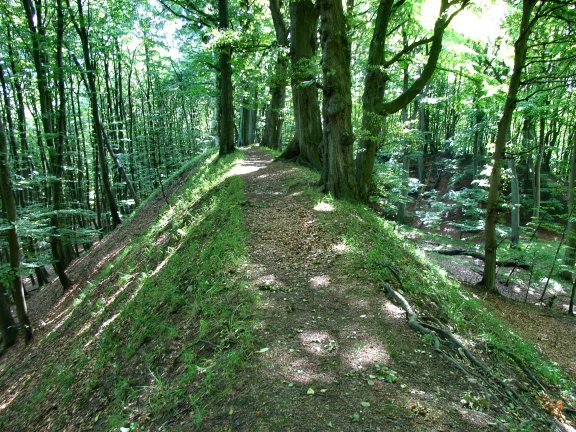 Part of the HERTHA CASTLE outer wall embankment. The Castle is thought to have
been built on the site of a Bronze Age settlement. In this Castle the Slawen
people of Rügen worshipped a Goddess they called HERTHA [HEOROTHA] whom
they perceived to be Mother Earth.
Part of the HERTHA CASTLE outer wall embankment. The Castle is thought to have
been built on the site of a Bronze Age settlement. In this Castle the Slawen
people of Rügen worshipped a Goddess they called HERTHA [HEOROTHA] whom
they perceived to be Mother Earth.
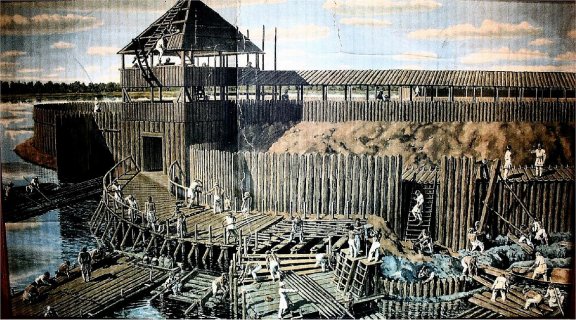 This is what the Slawen HERTHA CASTLE may have originally looked like.
This is what the Slawen HERTHA CASTLE may have originally looked like.
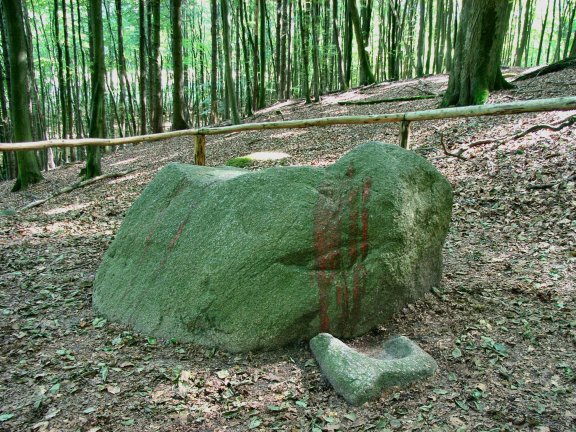 This is thought to be a ritual stone at HERTHA CASTLE, hence someone has spilt
red paint over it for a more dramatic effect !!
This is thought to be a ritual stone at HERTHA CASTLE, hence someone has spilt
red paint over it for a more dramatic effect !!
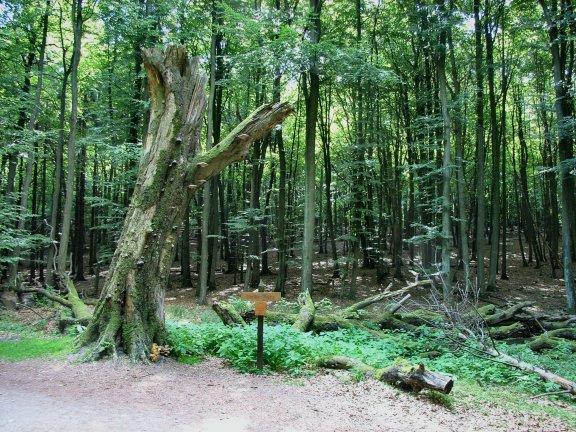
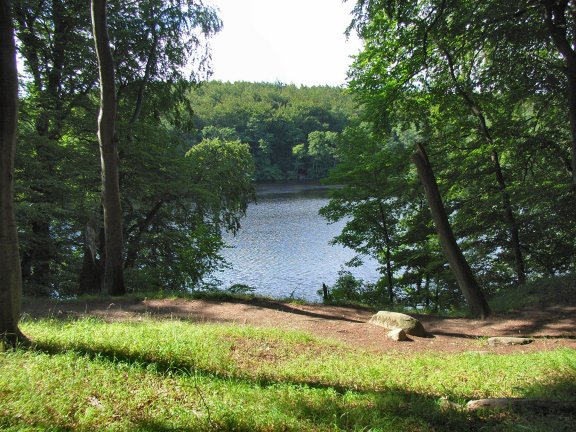 Not far from HERTHA CASTLE there is a deep, dark lake, called the Black Lake
or Burgsee [HERTHASEE], surrounded by ancient beech woods [HERTHABUCHE] and
hills. The Goddess bathed there several times each year.
Not far from HERTHA CASTLE there is a deep, dark lake, called the Black Lake
or Burgsee [HERTHASEE], surrounded by ancient beech woods [HERTHABUCHE] and
hills. The Goddess bathed there several times each year.
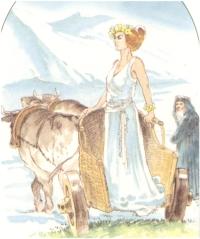 HERTHA descended from the Throne of Odin and rode there in a chariot,
a carriage covered with a mysterious veil and drawn by two cows. Wherever she
condescends to come and accept the hospitality of humans, there are days of
rejoicing and weddings, no war is fought, no weapon reached for, every iron
object is locked away. Only peace and calm are then known and desired. This
lasts until the Goddess has sojourned long enough among humans and the priest
leads her back again into her sanctuary. Only her consecrated priest was allowed
to accompany her. Slaves were also brought along to lead the draft animals and
to wash the chariot, but they were drowned in the lake immediately upon completing
their task, because any unconsecrated person who caught sight of the Goddess
would have to die. For this reason nothing more is known about the worship of
this Goddess.
HERTHA descended from the Throne of Odin and rode there in a chariot,
a carriage covered with a mysterious veil and drawn by two cows. Wherever she
condescends to come and accept the hospitality of humans, there are days of
rejoicing and weddings, no war is fought, no weapon reached for, every iron
object is locked away. Only peace and calm are then known and desired. This
lasts until the Goddess has sojourned long enough among humans and the priest
leads her back again into her sanctuary. Only her consecrated priest was allowed
to accompany her. Slaves were also brought along to lead the draft animals and
to wash the chariot, but they were drowned in the lake immediately upon completing
their task, because any unconsecrated person who caught sight of the Goddess
would have to die. For this reason nothing more is known about the worship of
this Goddess.
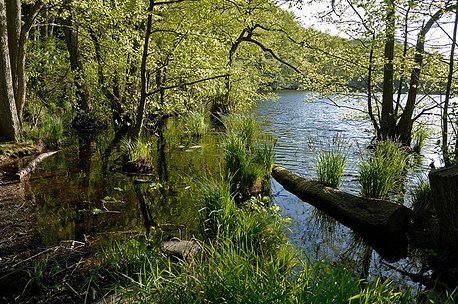 There are
all kinds of stories about uncanny happenings near this lake. Some believe that
these are caused by the Devil, who, in the form of the Goddess Hertha, was worshipped
by the people and who therefore still lays claim to the lake. Others believe
that these happenings are caused by an ancient Queen or Princess who had been
banished to this place. Especially when the moon is shining brightly, a beautiful
woman is often seen emerging from the woods adjacent to HERTHA CASTLE. She proceeds
to the lake, where she bathes herself. She is surrounded by many female servants,
who accompany her into the water. Then they all disappear, but they can be heard
splashing about. After a while they all appear again, and they can be seen returning
to the woods dressed in long white veils. It is very dangerous for a wanderer
to observe this, for he will be drawn by force into the lake where the white
woman is bathing, and as soon as he touches the water, he will be powerless;
the water will swallow him up. They say that the woman has to lure one human
into the water every year. No one is allowed to use boats or nets on this lake.
Some time ago some people dared to bring a boat to the lake. They left it afloat
overnight, and when they returned the next morning, it had disappeared. After
a long search, they found it atop a beech tree on the bank. It was spirits of
the lake that had put it up there during the night, for when the people were
getting it back down, they heard a spiteful voice calling to them from beneath
the lake, saying: "My brother Nickel and I did it!" That is the reason this
cult is no longer followed.
There are
all kinds of stories about uncanny happenings near this lake. Some believe that
these are caused by the Devil, who, in the form of the Goddess Hertha, was worshipped
by the people and who therefore still lays claim to the lake. Others believe
that these happenings are caused by an ancient Queen or Princess who had been
banished to this place. Especially when the moon is shining brightly, a beautiful
woman is often seen emerging from the woods adjacent to HERTHA CASTLE. She proceeds
to the lake, where she bathes herself. She is surrounded by many female servants,
who accompany her into the water. Then they all disappear, but they can be heard
splashing about. After a while they all appear again, and they can be seen returning
to the woods dressed in long white veils. It is very dangerous for a wanderer
to observe this, for he will be drawn by force into the lake where the white
woman is bathing, and as soon as he touches the water, he will be powerless;
the water will swallow him up. They say that the woman has to lure one human
into the water every year. No one is allowed to use boats or nets on this lake.
Some time ago some people dared to bring a boat to the lake. They left it afloat
overnight, and when they returned the next morning, it had disappeared. After
a long search, they found it atop a beech tree on the bank. It was spirits of
the lake that had put it up there during the night, for when the people were
getting it back down, they heard a spiteful voice calling to them from beneath
the lake, saying: "My brother Nickel and I did it!" That is the reason this
cult is no longer followed.
In
other German tribes when there was a drought, it was usual to take the most
beautiful maiden from the village and send her totally naked at the head of
a procession of women across the fields where crops are grown. This rite was
not just followed on the Island of Rügen but was also followed on the Island
of Helgoland or HOLY LAND [at the mouth of the River Elbe] where
Angles worshipped HERTHA in Festivals at her Temple, as well as in Saxony and
in Scandinavia, where the legend is preserved in local traditions and her sacred
groves and lakes are still observed in Festivals.
TACITUS [AD56-AD117] was a Roman Senator and Historian. He mentioned the same
ritual concerning NERTHUS [ERCE] in his work, GERMANIA. At the full moon a young
woman frequently appears around the Castle. She bathes in the lake, accompanied
by nymphs. After a while they disappear. They are wrapped in long, white dresses.
Passers-by, especially men, who see the swimmers accidentally, by the water
of the lake are blinded. In this aspect the Goddess corresponds to the Roman
DIANA in the forest of Nemi
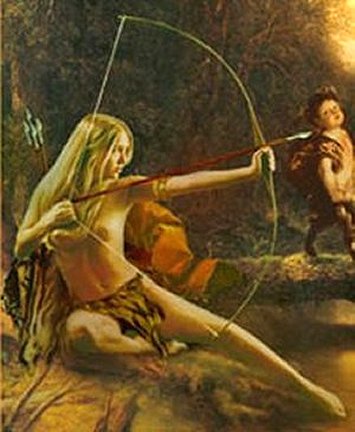 and
the Greek Goddess of Hunting ARTEMIS [who had her Chariot drawn by STAGS]. Oak
groves were especially sacred to her. She was praised in poetry for her strength,
athletic grace, distinct beauty and hunting skill. He describes a sacrifice
to this Goddess in a lake on what is sometimes interpreted as the island of
Fyn, Denmark.
and
the Greek Goddess of Hunting ARTEMIS [who had her Chariot drawn by STAGS]. Oak
groves were especially sacred to her. She was praised in poetry for her strength,
athletic grace, distinct beauty and hunting skill. He describes a sacrifice
to this Goddess in a lake on what is sometimes interpreted as the island of
Fyn, Denmark.
"In an island of the ocean there is a Sacred Grove and in it a carriage
dedicated [to the Goddess], covered with a vestment; only one priest is allowed
to touch it. He feels the Goddess presence in her Shrine, and follows with great
veneration as she rides forth drawn by cows. Then come festive times for those
whom she dignifies with her hospitality. They do not make war, they do not take
up arms; all iron is put away; then, and only then, peace and quiet are known
and loved, until she is satiated with the company of humans and the same priest
returns the Goddess to her Sacred precinct. After this, the carriage and the
vestment and, if you wish to believe it, the Goddess herself, are washed in
a secret lake. Slaves do this ministry and are then swallowed by the same lake:
hence a mysterious terror and an ignorance full of reverence as to what that
may be which men see only to die." [Germania, ch. 40]
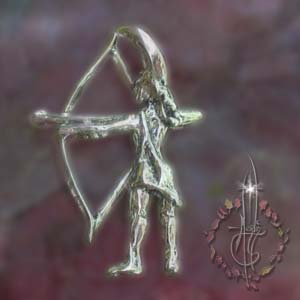 a Norse 'Artemis' amulet.
a Norse 'Artemis' amulet.  from a Pirelli tyre ad. 'Artemis'
from a Pirelli tyre ad. 'Artemis'
The name is closely related to the name NJORD, a God of the Sea in Norse mythology. Her name may have survived in a few Scandinavian place names. However, due to the thousand years that passed between Tacituss description and the Eddas, her role in Norse mythology can only be studied through speculation.
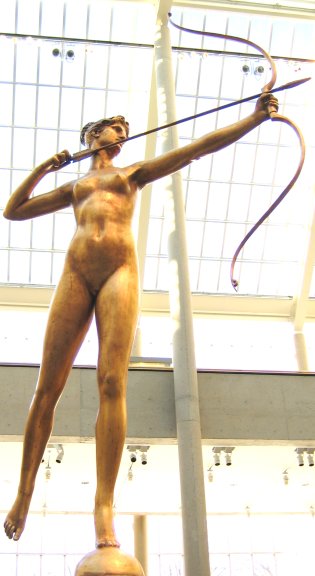 DIANA
was the Roman Goddess of Hunting and Wilderness. She was accompanied by a DEER,
a STAG. The deer offers a covert reference to the myth of Acteon [or Actaeon],
who saw her bathing naked. Diana transformed Acteon into a STAG and set his
own hunting dogs to kill him.
DIANA
was the Roman Goddess of Hunting and Wilderness. She was accompanied by a DEER,
a STAG. The deer offers a covert reference to the myth of Acteon [or Actaeon],
who saw her bathing naked. Diana transformed Acteon into a STAG and set his
own hunting dogs to kill him.
For medieval witches [and witches today] the Earth remained a Goddess. Those
witches the Hä Inquisition caught believed they became invisible and could escape,
if one permitted them to affect the Earth.
Diana is Queen of the Witches. Witches being the wise women healers of the time.
Goddess Diana created the world of her own being having in herself the seeds
of all creation yet to come. It is said that out of herself she divided into
the darkness and the light, keeping for herself the darkness of creation and
creating her brother Apollo, the light. Goddess Diana loved and ruled with her
brother Apollo, the God of the Sun. As time went on, the Earth was created and
Diana descended to Earth, as did her brother Apollo. Diana taught magic and
witches were born. One night using witchcraft in the form of a cat, His most
beloved animal, Diana tricked Apollo. She gained entrance to His chamber where
She seduced Him. From this union a daughter was born, goddess Aradia.
Today there is a branch of Wicca named for her, which is characterized by an
exclusive focus on the feminine aspect of the Divine.
hartleyfamilyorguk believes there is overwhelming evidence that the Germanic Earth Goddess HERTHA is the root of the family of Germanic surnames beginning with 'HART'. She is the key to understanding the Tribes that united to worship her and name places and peoples after her. They even named the Stag, the Hart, after her. The names 'HERTHA', 'HEOROT', 'ARTEMIS' and 'HART' are all one of the same. They are the 'Deer-Stag People' of Europe and Asia, her name living on in India, in Greece, in Italy, in Germania, in Scandinavia and in the British Isles and Ireland.
But where and when is the earliest use of the surname HARTLEY to be found in the British Isles and Ireland ?
The earliest HARTLEY surname, recorded in Norman times as 'DE HARCLA', later 'HARCLAY', thought by some to mean 'Hard Clay' ... the Bronze Age and Iron Age 'Carvetii' Tribe in Cumbria, 'the Deer/Stag People' had links to vitrified hill top forts through the Briantes. However hartleyfamilyorguk believes the surname DE HARCLA became the surname HARCLAY, and that eventually became HARTLEY. The surnames are one of the same, all connected with a Festival of the Goddess HERTHA, going back tens of thousands of years.
The HARTLEY Family of Chorlton-cum-Hardy in Manchester derived their name from 'Hearda's Island' at Chorlton, 'HERTHA'S ISLAND', an island where the Earth Goddess Hertha was celebrated and worshipped; in the Textus Roffensis [1125] HERDEI [see HARTLEY Family of Chorlton in Lancashire ]
the Norman 'DE HARCLA' family name originated in the South of England [Anglo-Saxon, probably Jute], named after the Goddess HERTHA. The surname later appeared in the North of England. Both uses of the surname became 'HARTLEY' over time; the surname has roots in HERTHA, hence 'Deer/Stag', not 'hard clay'.
It
looks highly likely that the surname HARTLEY was brought to Britain by Germanic
tribes, who named places in Britain where the FESTIVAL of HERTHA was observed.
Also Halls, Shrines and Temples were named after their Earth Mother Goddess,
HEOROTHA, HEOROT or HERTHA, hence the place-name became HEORT-LEA, eventually
HARTLEY.
The association of the Stag with the HERTHA Festival means the word HEORT, hence
'Hart', was used to mean 'Stag', not the other way round.
The Greek, Roman and Teutonic Goddesses, Artemis, Diana and Hertha live on within
the surname HARTLEY, with its links to the HEORT, the Stag, the Hart.
Could HARTLEY be a Norse-Viking surname ?
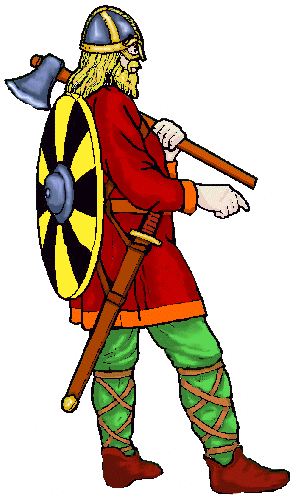 In Norse, 'Har' means 'tall' 'loud' and 'hair' ... so what might 'Har-t-ley'
mean in Norse ?
In Norse, 'Har' means 'tall' 'loud' and 'hair' ... so what might 'Har-t-ley'
mean in Norse ?
...
'Har' means tall, high, loud, [fair-]haired ... 'Hart' means 'hard' or 'sharply'
... ... the German 'Hardt' means 'hard', 'hardy', 'tough', 'strong' ...
'Ley'
may be derived from 'Lio' meaning 'peoples or clan' but it may be derived from
'ley' meaning 'grassland' ... in German 'ley' has that meaning.
so 'Hartley' might mean [something like] 'the Clan of the tall, hard, loud, fair-haired people' or it may mean 'The tough, hard peoples who live in the grasslands, meadows'.
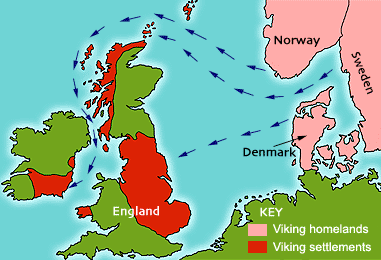 From about
800AD the East Norsemen Vikings [mostly Danes and Finns] controlled most of
Northern and Eastern Britain, an area from London up into Scotland and across
as far as Manchester, Lancashire and Cumbria, the exact same area where the
northern Hartleys originate. This area was called Northumbria [or Northumberland]
meaning the lands north of the River Humber; [the area south of the Humber called
Southumbria [or Southumberland].
From about
800AD the East Norsemen Vikings [mostly Danes and Finns] controlled most of
Northern and Eastern Britain, an area from London up into Scotland and across
as far as Manchester, Lancashire and Cumbria, the exact same area where the
northern Hartleys originate. This area was called Northumbria [or Northumberland]
meaning the lands north of the River Humber; [the area south of the Humber called
Southumbria [or Southumberland].
West
Norsemen Vikings [from Norway and Sweden] controlled Western Scotland and Islands,
Dublin and the South of Ireland and parts of Wales. Here are more similar maps:
[click on map to enlarge]
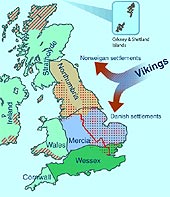
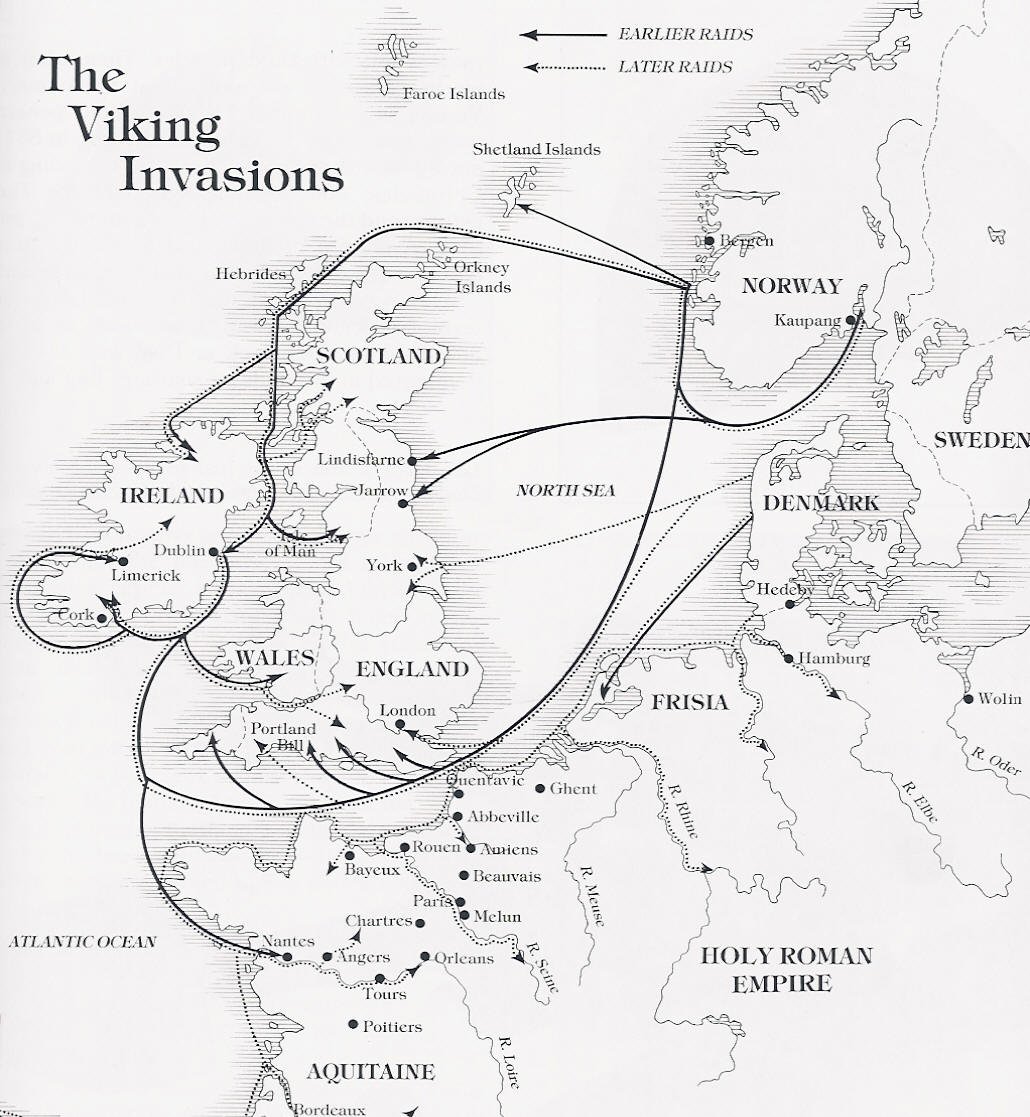
From
the maps it seems more than a coincidence, the areas settled by Viking Norsemen
correspond with where British and Irish Hartleys originate and populate most
frequently today [see Irish O'Hartley below].
hartleyfamilyorguk believes the surname HARTLEY is derived from a place where the Mother Earth Goddess HERTHA was worshipped; however, Norse-Vikings also worshipped the Mother Earth Goddess NERTHUS so they would have carried out a similar worship as the Anglo-Saxons, uniting the people in their beliefs.
What supports the view that the surname HARTLEY came from a place-name ?
Traditionalists
believe the origins of the surname HARTLEY are of local or toponymic origin
that is, derived from the name of the place of residence of the initial bearer.
That means the surname derives from the place-name HARTLEY, found in a number
of English counties including Cumbria, Lancashire, Northumberland, Staffordshire,
Berkshire, Hampshire, Devon, Dorset and Kent. Thus the original bearer of the
surname originated from one of the above places bearing the name HARTLEY.
[see 'sources' at ancestry.com]
hartleyfamilyuk believes this to be incorrect; HEORT was not derived from the name of the place ... it was the other way round, the place was named after the Germanic HEORT ... derived from the Earth Goddess HERTHA
Etymologists have many meanings for the surname HARTLEY; Hart, Stag, Hill, Hard, Bear, Hero ... found in different places across the British Isles and Ireland. What etymolists don't agree on is one, single meaning.
1] Several, in particular those in Hampshire, Kent, Dorset and Devon, are named from Old English heorot ‘hart’, ‘stag’ + leah ‘wood’, ‘clearing’.
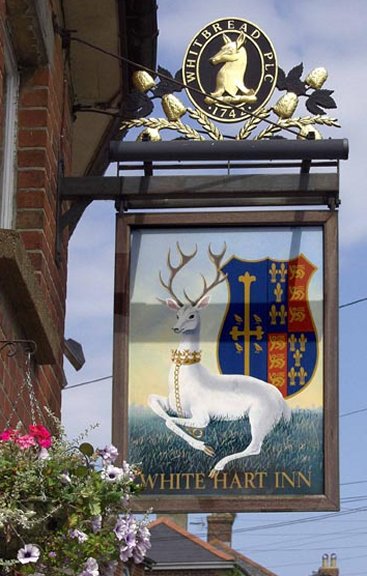 [According to 'etymologists', HARTLEY is a place-name, and derives from the
Old-English 'Hart' meaning a 'Stag' derived from the Norse/Saxon 'Heorte' meaning
'heart' and 'Leah' meaning a 'Meadow' or Clearing in a Wood'. [Saxon Terms:
350AD - 1000AD Ley or Lea = Clearing].
[According to 'etymologists', HARTLEY is a place-name, and derives from the
Old-English 'Hart' meaning a 'Stag' derived from the Norse/Saxon 'Heorte' meaning
'heart' and 'Leah' meaning a 'Meadow' or Clearing in a Wood'. [Saxon Terms:
350AD - 1000AD Ley or Lea = Clearing].
Virtually all of the place names decided on up to around the 14th Century were
due to the environment of the area.
But the German for 'deer' is 'hirsch' so one might ask why the name isn't
'Hirschley' if it is named after deer ?
2] One in Northumberland has as the second element Old English hlaw ‘hill’.
3] One in Cumbria contains Old English cla ‘claw’, in the sense of a
tongue of land between two streams, + probably heard ‘hard’.
[some believe the surname Hartley may have originated in the North from the
Norman surname 'de Harcla' [could also mean 'Hard Clay' reflecting the
vitrified ground around the area of Hartley Castle] [see the HARTLEY History
page] However, the name originated in Kent and Hampshire during Norman
times and travelled up country to Cumbria with the naming of the 13thC fortified
Manor Hall, 'Hartley Castle' .
4] The surname is widely distributed, but most common in Yorkshire, where it arose from a place near Haworth, West Yorkshire, also named with Old English heorot + leah.
5] As a Scottish name, it comes from the Cumbrian Hartley.
6] Irish: shortened Anglicized form of or surname adopted as equivalent
of Gaelic Ó hArtghaile ‘descendant of Artghal’, a personal name composed of
the elements Art ‘bear’, ‘hero’ + gal ‘valor’.
[ In Ireland, the surname O'HARTLEY is used in the anglicized form of Gaelic
Irish, formerly O'HARTILY , to be found in the south-east Leinster maritime
county of Wexford, 'The Garden of Ireland'. Some of the oldest records show
Hartleys around Dublin in the early 1600's]
THE
DOMESDAY BOOK The Domesday Book was commissioned in December 1085 by William
the Conqueror, the Norman King who invaded England in 1066. The first draft
was completed in August 1086 and contained records for 13,418 settlements in
the English counties south of the rivers Ribble and Tees [the border with Scotland
at the time].
HARTLEY was called in Domesday [1086] ERCLEI and in the Textus
Roffensis [1125] HERDEI.
The Saxon 'E' was pronounced as our 'A' and the sound of the 'C' against 'L'
is not unlike that of 'T' and 'L' so maybe the name should have been written
'ARTLEI' not 'ERCLEI' ? In the case of Hartley, near Cranbrook,
the Norman scribe wrote 'ARCLEI', a hal-way compromise ?
So 'ERCLEI' or 'ARCLEI' could be the Norman version of the Saxon
'HEORTLEA'.
In some places it looks like the name changed over time to: HERCLEGA,
then HURTLEGH, HERTELE, HERTELEGH, HERTLEYE [13thC] HURTLEYE [14thC] HERTELEY
[16thC] ... eventually HARTLEY.
In other places, HEORUTLEA HERETSLEY HERTELEIGH HERTLEGH HERTLEY HERTLEGE
HERKELEYE HERCLEYE HERDIE HARLEI HERLEI [11thC] HEORTLEA HERTELEY HARELEY HERTLIGH
[13thC] HURTLEGHE HERTLE [14thC] HERTILEE HERTELE HARTELEY
1.
Berkshire Index ••• Hartley ... http://www.domesdaybook.co.uk/berkshire.html
The parish of Shinfield is situated on the left bank of the River Loddon between
Stratfield Mortimer and Earley, and consists of a central ridge of high land
sloping eastwards to the Loddon and westwards towards the Kennet valley. Within
Shinfield are Hartley Dummer [and Hartley Court], Hartley
Amys, Hartley Pellitot, Hartley Battle and Hartley Regis
2.
Hampshire Index ••• Hartley Mauditt Hartley Wespall ... http://www.domesdaybook.co.uk/hampshire.html
Hartley
Wintney is a large parish situated 2 miles north from Winchfield. In the
immediate vicinity of Hazeley Heath, which is partly within Hartley Wintney,
gravel-pits are found. The village of Hartley Row lies on the main road
from Bagshot to Basingstoke. After leaving the village this road leads on past
Hartley Grange. At the time of the Domesday Survey HARTLEY WINTNEY was
probably included in the great royal manor of Odiham, and it is not mentioned
by name until the 12th century, when a priory was founded here.
Hartley Wespall is a parish and small village on the River Loddon situated 6 miles north-east from Basingstoke, separated from the river by a large stretch of common land called Hartley Wood Common. The water-mill called Hartley Mill probably marks the site of the mill which existed in 1086. Hartley House, in the extreme north of the parish, was formerly the rectory house.
3.
Kent Index ••• Hartley, Kent ... http://www.domesdaybook.co.uk/kent.html
There are two Hartleys in Kent, one near Cranbrook, just up from Hastings, and
the other near Longfield, Gravesend. The first has the longest recorded history
of the two, first mentioned in the year 843 as the Saxon village of HEORTATLEAG
[HEORTLEA] while the other is not found until the Domesday Book,
in which it appears as ERCLEI. The name comes from Old English HEOROT,
a Hart or Stag Deer, here combined with Leah ‘field, clearing’, giving a sense
of a clearing frequented by Stags. The name 'HART' must have close links to
the Dutch word for 'Deer', HERT. The Dutch have a particularly close
genetic link with Kent.
In
early Saxon times the western portion of Kent was divided into two lathes or
lands, taking their names from Elesford and Sudton. And these again were sub-divided
into hundreds. For 600 years of Saxon rule the first village of HEORTLEA
came into the lathe of Sudtone and the hundred of Axton.
The second HARTLEY contains about twelve hundred acres, part of which is a large wood, called Hartley Wood, containing one hundred and fifty acres, at the northern boundary of it; the soil of it is chalky, light, and much covered with flints. The church stands on the hill, round which there is no village, though here, and at Hartley Green, about a quarter of a mile northward from it, there are several stragling houses. The western part of this parish lies in the valley, called Hartley Bottom, along which the road leads to Wrotham and Trosley. This place, at the taking the survey of Domesday, was part of the vast possessions of Odo, the great Bishop of Baieux, and half-brother to the Conqueror; under the general title of whose lands it is thus described there. Ralph Fitz Turald holds Erclei of the Bishop of Baieux. It was taxed at one suling. The arable land is . . . . . In demesne there are 2 carucates and 9 villeins, with 6 cottagers, having 3 carucates. There are 3 servants, and wood for the pannage of 10 bogs. The whole manor was worth 3 pounds, and now 100 shillings; a certain woman held it. In the same record, a little further on, under the same title of the bishop of 'Baieux's lands, is this entry: Ralph Fitz Turald bolds Erclei of the Bishop of Baieux. It was taxed at 1 suling. The arable land is half a carucate, and there are now 30 acres of arable. In demesne there is 1 carucate and 6 villeins, having half a carucate. There are 12 acres of meadow. In the time of King Edward the Confessor and afterwards, it was 40 shillings, now 4 pounds. Hunef, held it of earl Harold. On the disgrace of the Bishop of Baieux, which happened about four years after the taking this survey, all his lands and possessions became forfeited to the Crown.
THE MANOR OF HARTLEY, soon after the Conqueror's reign, became part of the possessions of the noble family of Montchensie, one of whom, Warine de Montchensie, was owner of it in the reign of King John.
4.
Berkshire D-M ••• Hartley Hurlei: Ralph de Mortimer*. Hartley
Court. Hartridge Hurterige: Alfred from William FitzAnsculf. Hartridge Farm.
... http://www.domesdaybook.co.uk/berkshire2.html
*Ralph de Mortemer, Seine-Maritime. Son of Roger. Lord of Wigmore Castle. Received
lands which had been Earl Roger of Hereford's after his rebellion, 1075. Lands
in 13 counties all over the country.
Note: the Domesday Book omitted references to HARTLEY in Dorset and HARTLEY 'DE HARCLA' in Cumbria so they likely appeared after the Normans.
hartleyfamilyuk believes this all goes to confirm, HEORT was not derived from a place where stags rutted ... it was the other way round, the place was named after the Germanic HEORT ... derived from the Earth Goddess HERTHA
So who were some of the earliest HARTLEYs and where did they come from ? Are we all descended from them ? And are all HARTLEYs related to one another ?
continued on Page 3:
1] Who are the Hartleys ? When did they originate ?
2] Where did the surname 'HARTLEY' come from ? Why the surname, HARTLEY ?
3] Who were some of the earliest HARTLEYs and where did they come from ?
please bookmark this website address: hartleyfamily.uk
e-mail enquiries to: william@hartleyfamily.uk